Planted aquariums are a huge favorite of mine, but I’m the first to admit that maintaining aquatic plants is a lot harder than raising tropical fish. I’m often asked, “why are my plants dying or turning yellow?” If you’ve ever wondered why your aquarium plants are turning brown or not thriving, then this guide is for you!
Troubleshooting Problems With Freshwater Plants

The most common reason for yellow, brown, or black leaves on aquatic plants is poor water quality. Plants are far more sensitive to their water conditions than most animals and show signs of stress when things are out of balance. In community tanks, plants act as the canary in the coal mine and send out early warning signs.
Plants rely on the nutrients in your substrate and floating in your water, and depend on your aquarium lights to give them the ideal spectrums of colors for photosynthesis. When your plants are not thriving, that’s a sign there’s a bigger problem with your tank. How do your troubleshoot, identify and fix the issue to bring your plants back?
How to Tell if Your Plant Nutrients Are Out of Balance
One of the first places to start looking for the problem is by examining your overall water quality. In addition to checking your pH, water hardness and ammonia levels, you should also examine your plants and see if you can spot symptoms that point to an excess or lack of specific nutrients or trace elements.
Macronutrients
Macronutrients are those most critical to healthy plants and that aquarium plants need in large amounts. You’ll often find these nutrients in balanced plant fertilizers, but that doesn’t mean you should just add fertilizer anytime you have a problem. Here are the most important macronutrients and how they impact your plants.
Carbon
If you’ve ever taken an organic chemistry class then you already know that without carbon (C), there’s no life on planet Earth. Every living creature depends on the abundance of carbon for survival. Plants mostly utilize carbon from carbon dioxide (CO2), since it’s an essential component of photosynthesis.
Signs of Carbon Deficiency
Carbon deficiency is a very common problem in planted aquariums. In fact, this is the most likely reason I’ve run across for poor plant growth and a failure to thrive. Some of the signs that your tank needs more carbon to include:
- Stunted or weak plant growth
- Pale or yellow leaves
- Yellow plants with dead leaves leading to dead plants
Adjusting CO2 Levels in an Aquarium
Since CO2 is a gas, it can be a little harder to supplement in an aquarium than the other macronutrients. Altering your CO2 levels can also change your water’s pH, so keep an eye on that as you’re making adjustments. Some techniques to increase the available CO2 in your tank include:

- Use a carbon injection system or add a carbon-based liquid fertilizer to the water every day
- Cycle the lights on and off during the day to allow the CO2 from your fish and bacteria to naturally increase the levels in the water
- Choose slow-growing plants and reduce the amount of light that your tank gets to slow down your plant’s photosynthesis, allowing CO2 to build-up naturally
- Reduce your water currents and remove bubbling devices to slow the loss of gaseous CO2 from your tank’s water
Phosphorus
Phosphorus (P) is also a tricky macronutrient to manage, because plants can suffer when there is a deficiency but also struggle if there’s too much. Water testing kits measure the inorganic phosphates in your water, but can’t detect the organic ones. The ideal levels for a planted tank are right around 0.5 ppm (mg/L).
Deficient Phosphate Levels

Phosphates (PO4) are usually present in tap water and added via the carbon filter media, fish foods, buffering solutions, and aquarium salts. Organic phosphates are produced by decaying plant materials, food scraps, and fish waste. When your phosphate levels are too low:
- Mature leaves develop yellow patches that disintegrate, leading to large, ragged holes in the leaves before they fall off and die
- If your plant’s new leaves are quickly turning yellow and dying, you probably need to check your phosphate levels and add a balanced fertilizer
Excess Phosphate Levels
Higher organic phosphate levels can increase plant growth up to a point, but also often lead to algae outbreaks, especially the dreaded green spot (GSA) and green water algae (GWA). This usually happens when you skip water changes and inconsistently maintain your tank. If there’s too much phosphate in your water:
- Your plant’s leaves may turn brown or black, and the plants start dying
- Test your phosphate and ammonia/nitrate levels, do a 50% water change and really vacuum your substrate to remove decaying materials!
Nitrogen
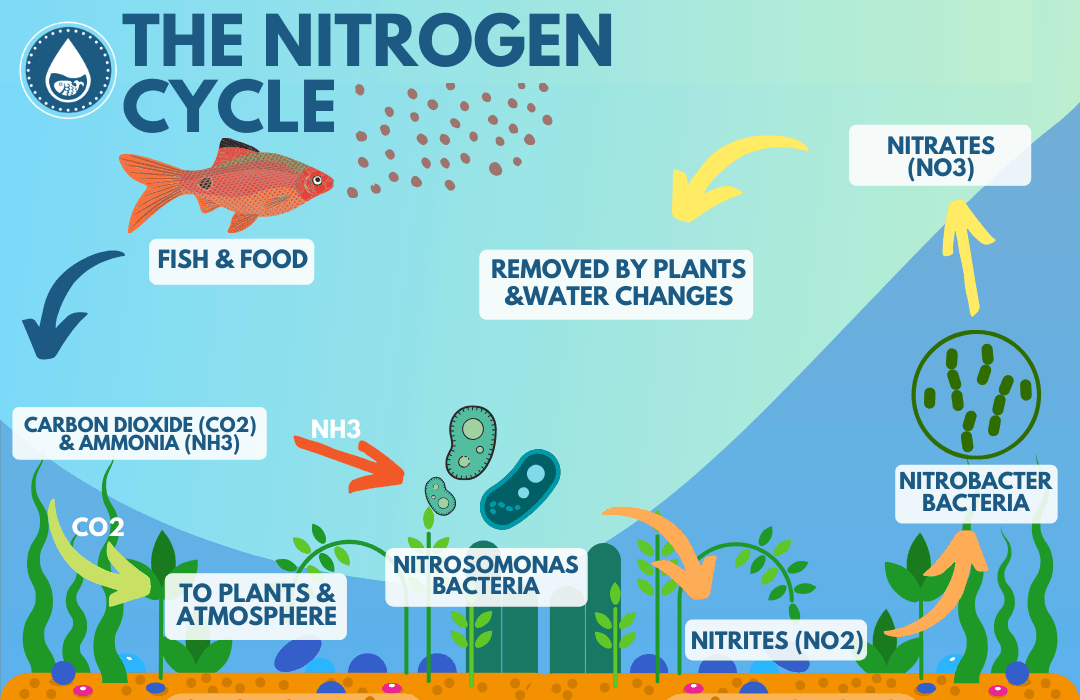
Nitrogen (N) is the most abundant element in our atmosphere, and both plants and your good aquatic bacteria rely on the nitrogen in your tank to grow and thrive. Aquatic forms of nitrogen include nitrate (NO3), ammonia (NH3) and ammonium (NH4). These are also essential components of the nitrogen cycle in a fish tank.
Deficient Nitrate Levels
One advantage of planted aquariums is they don’t usually have problems with excess ammonia or nitrate levels because the plants use these nutrients before they can cause harm to your fish. However, in densely planted tanks with few fish you may not have enough waste to keep the cycle moving. Low nitrogen can lead to:
- Mature plant leaves that turn yellow and fall off
- Yellow or stunted new growth
- Warped or reddish-colored new leaves
Excess Nitrate or Ammonia Levels
This is a less-common problem in planted tanks, but if you add a lot of plants to a new tank before it’s properly cycled, you may not have enough of the good bacteria to break down the fish’s waste products into usable nitrates. Your new plants may turn yellow, brown or black and die. I talk more about how to handle new tanks below.
Potassium

Potassium (K) is a critical nutrient for plant growth and one of the more common to have deficiencies in, since plants use it in large amounts. It’s a little tricky to fix since your potassium levels fluctuate with and are influenced by your CO2, pH and water hardness levels. Most planted tanks benefit from potassium supplements:
- When your potassium is too low, you’ll usually notice tiny yellow pinholes in your plant’s leaves
- You may also see yellowish discoloration along the edges of the leaves, but unlike the magnesium-deficient plants below, the leaf will look normal other than the yellow edges
Magnesium
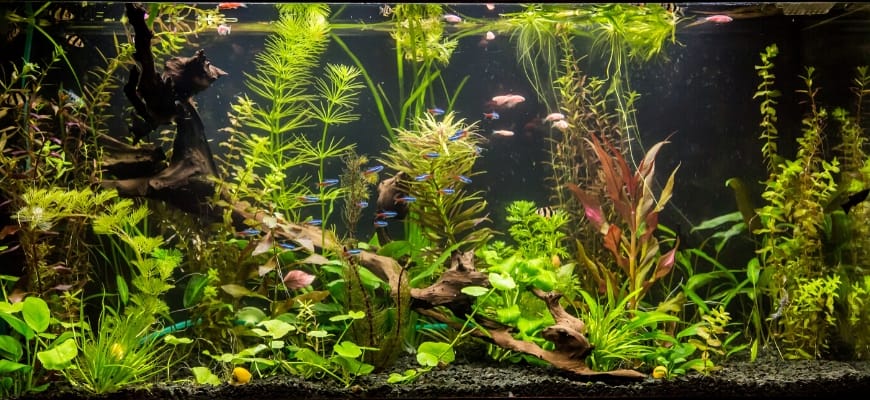
Magnesium (Mg) is one of the most important nutrients and lends a hand in keeping your plants healthy and green. Low magnesium can also resemble iron deficiency, and the two go together, since a lack of magnesium reduces the amount of iron your plants can absorb. You’ll often have to fix the problem with a good fertilizer.
- If your magnesium is deficient, established plants turn yellow along the edges or develop yellow spots on the older leaves
- Magnesium deficiency can also look similar to a deficiency of potassium, but the veins of the leaves usually remain green even as the leaf turns yellow
Micronutrients
Plants also utilize other trace elements in smaller quantities, such as iron, manganese, boron, and molybdenum. Between your substrate, fertilizers and water changes you’ll usually have these nutrients in sufficient supply. The most common deficiencies in micronutrients are low iron (Fe) and manganese (Mn) levels.
Iron

Iron-rich substrates like Flourite and iron-containing fertilizers are a great way to prevent deficiencies and support lush plant growth. It depends on the form, however, as some types of iron are not soluble and are thus unavailable to your plants. In the early stages of iron deficiency, you’ll see symptoms like:
- New growth and tips of leaves look pale, yellow or white
- Mature leaves turn pale yellow advancing to transparent or white, with green veins showing through (chlorosis)
- In advanced cases of iron deficiency, the leaves and plants will look very stunted and eventually turn black as the tissues turn necrotic and die
Manganese

Manganese is vital for your plant’s metabolism, and deficient plants often have problems with their photosynthesis and growth. Plants suffering from low manganese levels often have similar symptoms to those with iron deficiencies. Luckily, most iron-rich fertilizers contain traces of manganese as well. Symptoms include:
- New growth looks pale or yellow
- Leaves develop yellow spots, leading to ragged holes between the leaf’s veins
Additional Causes for Brown Aquatic Plants
Nutritional deficiencies are not the only reason for aquatic plants to turn brown or die. As I mentioned above, your overall water quality, lighting conditions and substrate also play a role in the health of your plants.
Poor Aquarium Maintenance
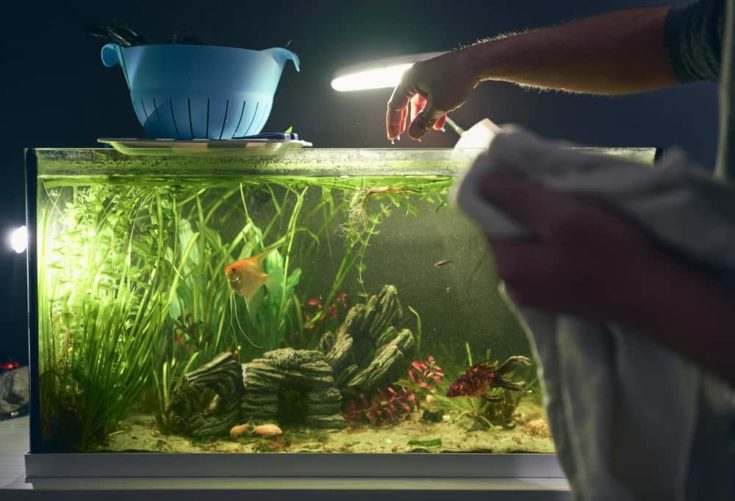
I learned the hard way that planted aquariums require more frequent water changes than fish-only tanks. When I started my first planted community I made the mistake of doing water changes only once a month, like I always had done. Not surprisingly, my plants didn’t fare well at first.
Once I started doing more frequent water changes and added ammonia-removing media to my filtration systems, my plants started shooting up. I didn’t know how to diagnose specific nutrient deficiencies, so I used a balanced fertilizer after each water change. This could be all you need to do to solve a brown plant problem!
Inadequate Lighting Conditions
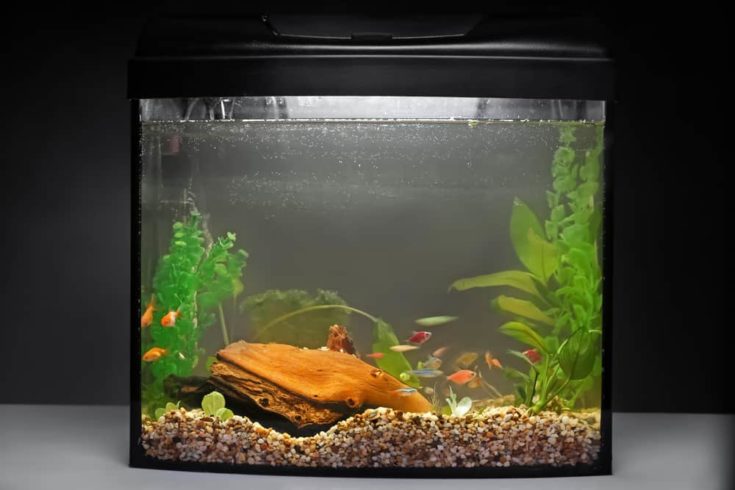
Back in the old days, if you wanted a thriving planted aquarium you needed to invest in the best light set-ups and frequently replace the bulbs. With modern LED aquarium lights things have gotten cheaper and you won’t need to swap out the diodes as often. As long as your plants get the right spectrums of light, they should do well!
It depends on your plants, however. Easy-to-grow aquatic plants often don’t have very strict requirements. If you’re planning on a densely planted or aquascaped tank or to want more challenging plants, you may need a higher quality light fixture to support their growth. Excess light and nutrients can cause algae problems, though!
Inappropriate Substrate for Planted Tanks

For setting-up fish-only communities, your substrate is usually not a critical choice to worry about. But planted aquariums rely on the substrate for nutrition and to support the bacterial colonies that break ammonia down into usable nitrates. If you choose a sandy substrate, you may actually prevent your plants from thriving!
Sand and colored aquarium gravels lack trace minerals and nutrients to support lush plant growth. Sand also compacts down easily, leading to dead zones in your aquarium and substrate that are devoid of oxygen. I recommend using a substrate designed for planted tanks, and boost the effect with a balanced fertilizer!
Plant Symptom(s)
Leaves turning brown/black
Possible Cause(s)
Too much phosphorus/high phosphate levels
Too much ammonia/high nitrate levels
Advanced iron deficiency
Remedy(s)
Water changes and new maintenance schedule
Improve water conditions with better filtration/filter media
Use an iron-rich fertilizer
Plant Symptom(s)
Mature leaves turning yellow
Possible Cause(s)
Light deficiency
Potassium or magnesium deficiency
Carbon deficiency
Deficient nitrate levels
Remedy(s)
Improve lighting
Use a balanced fertilizer
Increase CO2 levels
Add fish or use a balanced fertilizer
Plant Symptom(s)
Spindly or weak growth
Possible Cause(s)
Carbon deficiency
Nutrient deficiency
Light deficiency
Remedy(s)
Increase CO2 levels
Use a balanced fertilizer
Improve lighting
Plant Symptom(s)
Growth stops/plants dying
Possible Cause(s)
Low water temperatures
Carbon deficiency
Advanced iron deficiency
Remedy(s)
Use aquarium heater to stabilize the temperature
Increase CO2 levels
Use an iron-rich fertilizer
Plant Symptom(s)
Large Holes in the leaves
Possible Cause(s)
Poor water quality
Excess nitrate levels
Remedy(s)
Improve water conditions
Water changes and new maintenance schedule
Plant Symptom(s)
Brittle leaves, yellow new growth or yellow spots on leaves leading to holes
Possible Cause(s)
Magnesium deficiency
Iron or manganese deficiency
Potassium deficiency
Excess pH levels
Remedy(s)
Use a magnesium supplement
Use an iron-rich fertilizer with trace minerals
Use a balanced fertilizer
Check pH levels and correct
Plant Symptom(s)
Leaves or whole plant turning white or transparent
Possible Cause(s)
Iron or manganese deficiency
Light deficiency
Remedy(s)
Use an iron-rich fertilizer with trace elements
Improve lighting
Other Common Problems with Planted Aquariums
When your aquarium plants are turning black or dying, the first things to consider are a deficiency of nutrients, water quality problems or a lack of sufficient light to support plant growth. But those are not the only reasons folks struggle with planted tanks!
New Tank Syndrome and Plant Problems
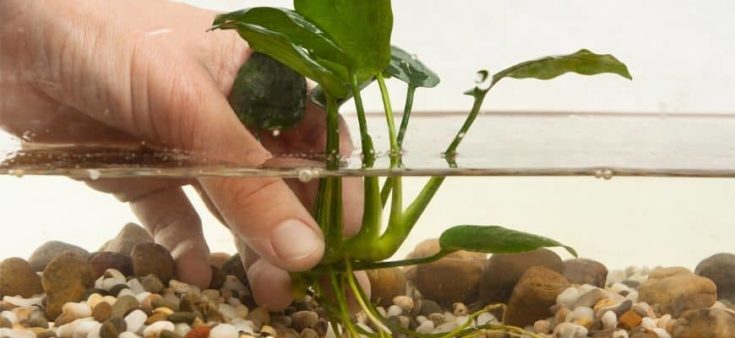
One really common error I made myself was adding plants to a new aquarium that hadn’t completely cycled. Since your plants rely on the populations of aquatic bacteria to break down ammonia into nitrate, a tank that is cycling often has spikes and crashes in their levels, and these rapid swings can stunt and kill delicate plants.
Until you have stable populations of good aquatic bacteria, which can take roughly 3 to 6 weeks, it’s best to skip dense plantings and instead pick a few fast-growing and hearty test-plants like hornwort. A few bunches can quickly use up nutrients to help prevent algae outbreaks, and they’re tough enough to make it through the spikes.
Brown Spots on Plant Leaves
Not all brown plant problems are tied to nutrient fluctuations, at least not directly. If your plants start developing rusty-colored brown spots on the leaves, especially if it’s a new tank that’s still cycling, you’re likely dealing with an outbreak of brown algae instead of a nutrient deficiency. If the spots rub off and feel a bit gritty, it’s algae.
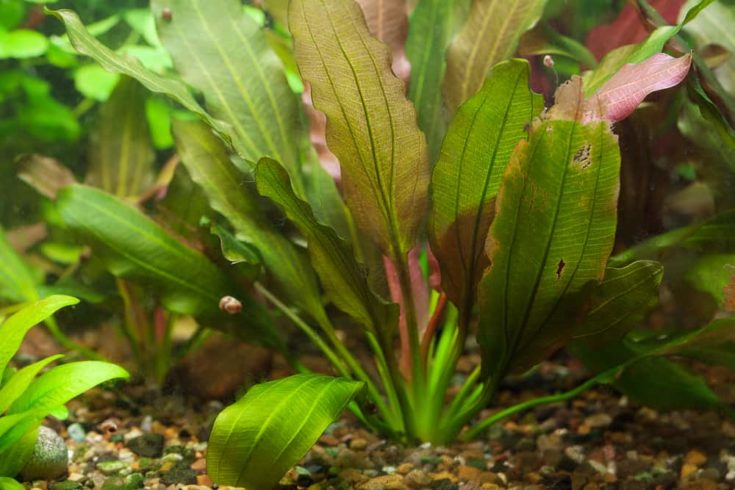
If you’re wondering how to clean brownish spotted leaves, the truth is you might not need to bother. Brown algae usually appear in newly cycling tanks and go away on their own once the nitrogen cycle is established. You can wait for the problem out, do extra water changes to lower the nutrient levels, or get an algae-eating Otocinclus!
Conclusion
It’s easier to prevent your aquarium plants from turning yellow, brown or black than it is to bring them back from near-death. If you’re diligent with maintaining your water quality, choose the proper substrate and lighting conditions for your type of plants and regularly apply a balanced fertilizer, your plants will likely stay green!
When and if plant problems do crop up in your tank:
- Troubleshoot the problem by examining your plants and test your water for the likeliest suspects
- Do a water change or two and be sure your filtration system and lights are in good condition
- Use the right type of fertilizer (if needed) and change-up your maintenance schedule to get things back on track!


Thanks for sharing your experience and expertise. It has been a struggle to maintain plants in my 75 gallon vs my 20 gallon tanks. I now know why after reading your piece on key necessities to keeping aquarium plants. It will help me start correcting and tweaking what’s needed towards better success keeping healthy plants.
everyone should have a HOSPITAL TANK meaning a TANK where you grow plants and heal fish.. i keep all my new plants in a HOSPITALs which is very clean no fish live there …. those plants grow expand i transfer a batch to the main aquarium repeat.. never buy plants again.
I have a 250. Gallon tank
And have filled it with plant I have recently had an ammonia outbreak and it killed off 20
Fish I’ve only got 7 left so I have started again so I’ve bought a few pants to put in my tank have I done the right thing